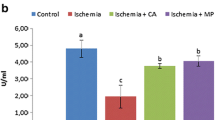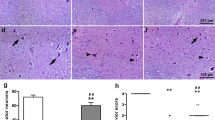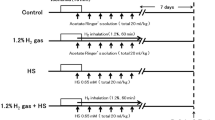Abstract
To test the effects of ketamine on metal ion balance in the spinal cord tissues after ischemic reperfusion (I/R), 24 white adult Japanese rabbits were randomly assigned to sham operation group, I/R group or ketamine-treated I/R group. Spinal cord injuries in I/R group and ketamine-treated I/R group were induced by aortic occlusions. Rabbits in ketamine-treated I/R group were intravenously infused 10 mg/kg ketamine twice: once at 10 min before aortic clamping and once at the onset of reperfusion. Post-operative neurological functions and concentrations of ions Ca2+, Mg2+, Cu2+ and Zn2+ in the spinal cord were assessed. Compared with the sham operation group, rabbits in the I/R group showed significantly worsened neurological functions as scored with the modified Tarlov criteria and altered concentrations of ions Ca2+, Mg2+, Cu2+ and Zn2+. These unfavorable changes were significantly reversed in the ketamine-treated I/R group, suggesting that the potent protective effects of ketamine against the I/R-induced spinal cord injuries may be due to its ability to maintain ion balance in the I/R affected tissues.
Similar content being viewed by others
References
Rokkas CK, Helfrich LR, Lobner DC et al (1994) Dextrorphan inhibits the release of excitatory amino acids during spinal cord ischemia. Ann Thorac Surg 58:312–319
Paolo B, Fabrizio G, Sara B et al (2006) Expression of AMPA and NMDA receptor subunits in the cervical spinal cord of wobbler mice. BMC Neurosci V7:71–78
Danielisova V, Chavko M (1998) Comparative effects of the N-methyl-d-aspartate antagonist MK-801 and the calcium channel blocker KB-2796 on neurologic and metabolic recovery after spinal cord ischemia. Exp Neurol 149:203–208
White PF, Way WL, Trevor AJ (1982) Ketamine: its pharmacology and therapeutic uses. Anesthesiology 56:119
Neuhaeuser C, Preiss V, Mueller M et al (2007) Intravenous anesthesia with S-(+)-ketamine for ‘on-pump’ coronary artery bypass surgery: hemodynamic profile and effect on troponin T levels. Crit Care 11:431–437
Yu QJ, Zhou QS, Huang HB et al (2008) Protective effect of ketamine on ischemic spinal cord injury in rabbits. Ann Vasc Surg 22(3):432–439
Yu QJ, Wang YL, Zhou QS et al (2006) Effect of repetitive ischemic preconditioning on spinal cord ischemia in a rabbit model. Life Sci 79:1479–1483
Naslund TC, Hollier LH, Money SR et al (1992) Protecting the ischemic spinal cord during aortic clamping. The influence of anesthetics and hypothermia. Ann Surg 215:409–515
Flores J, Shiiya N, Kunihara T et al (2005) Risk of spinal cord injury after operations of recurrent aneurysms of the descending aorta. Ann Thorac Surg 79:1245–1249
Najafi H, Javid H, Hunter J et al (1980) Descending aortic aneurysmectomy without adjuncts to avoid ischemia. Ann Thorac Surg 30:325–326
Cox GS, Hara PJ, Hertzer NR et al (1992) Thoracoabdominal aneurysm repair: a representative experience. J Vasc Surg 15:780–787
Svensson LG, Crawford ES, Hess KR et al (1990) Dissection of the aorta and dissecting aortic aneurysms. Improving early and long-term surgical results. Circulation 82:IV24–IV38
Miller RD (2001) Anesthesia, 5th edn. Churchill Livingstone, New York, pp 1869–1873
Mauney MC, Blackbourne LH, Langenburg SE et al (1995) Prevention of spinal cord injury after repair of the thoracic or thoracoabdominal aorta. Ann Thorac Surg 59:245–252
Svensson LG, Crawford ES, Hess KR et al (1993) Experience with 1,509 patients undergoing thoracoabdominal aortic operation. J Vasc Surg 17:357–368
Kouchi I, Murakami T, Nawada R et al (1998) KATP channels are common mediators of ischemic and calcium preconditioning in rabbits. Am J Physiol Heart Circ Physiol 274:1106–1112
Shen C, Jiang S, Dong Y (2001) Changes of trace element in the acute spinal cord injury. Chin J Tradit Med Traumatol & Orthop 9:14–16
Knott TK, Marrero HG, Fenton RA et al (2007) Endogenous adenosine inhibits CNS terminal Ca(2+) currents and exocytosis. J Cell Physiol 210:309–314
Momose-Sato Y, Kinoshita M, Sato K (2007) GABA-induced intracellular Ca2+ elevation in the embryonic chick brainstem slice. Neurosci Lett 411:42–46
Muto O, Ando H, Ono T et al (2007) Reduction of oxaliplatin-related neurotoxicity by calcium and magnesium infusions. Gan To Kagaku Ryoho 34:579–581
Ditor DS, John SM, Roy J et al (2007) Effects of polyethylene glycol and magnesium sulfate administration on clinically relevant neurological outcomes after spinal cord injury in the rat. J Neurosci Res 85:1458–1467
Tokuda E, Ono S, Ishige K et al (2007) Metallothionein proteins expression, copper and zinc concentrations, and lipid peroxidation level in a rodent model for amyotrophic lateral sclerosis. Toxicology 229:33–41
Yu RA, Xia T, Wang AG et al (2006) Effects of selenium and zinc on renal oxidative stress and apoptosis induced by fluoride in rats. Biomed Environ Sci 19:439–444
Ozdemir M, Cengiz SL, Gürbilek M et al (2005) Effects of magnesium sulfate on spinal cord tissue lactate and malondialdehyde levels after spinal cord trauma. Magnes Res 18:170–174
Kalkan E, Ciçek O, Unlü A et al (2007) The effects of prophylactic zinc and melatonin application on experimental spinal cord ischemia-reperfusion injury in rabbits: experimental study. Spinal Cord 45:722–730
Acknowledgments
We thank Xianxiong Gui from Renmin Hospital of Wuhan University for her constant assistance during the entire study.
Author information
Authors and Affiliations
Corresponding author
Rights and permissions
About this article
Cite this article
Yu, Q.J., Zhou, Q.S., Huang, H.B. et al. Effects of Ketamine on the Balance of Ions Ca2+, Mg2+, Cu2+ and Zn2+ in the Ischemia-reperfusion Affected Spinal Cord Tissues in Rabbits. Neurochem Res 34, 2192–2196 (2009). https://doi.org/10.1007/s11064-009-0019-4
Received:
Accepted:
Published:
Issue Date:
DOI: https://doi.org/10.1007/s11064-009-0019-4




